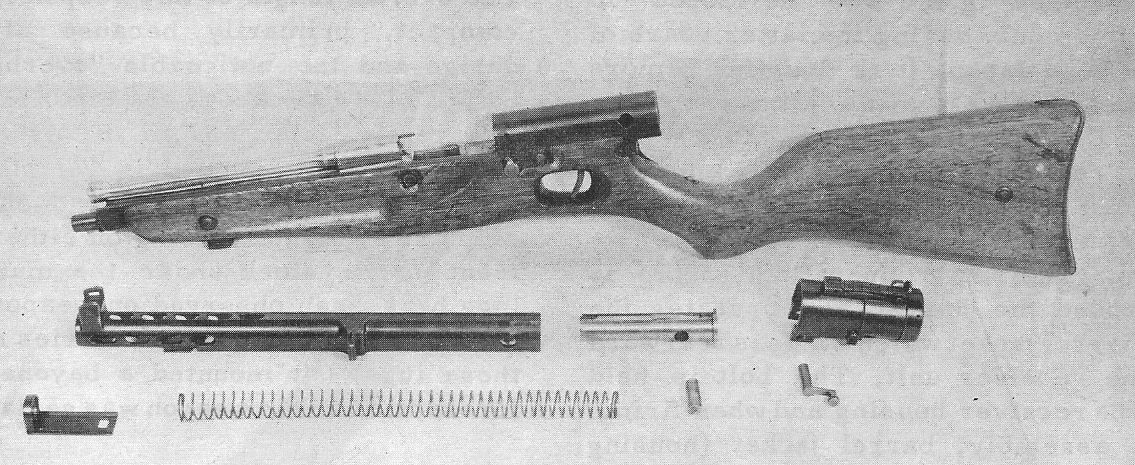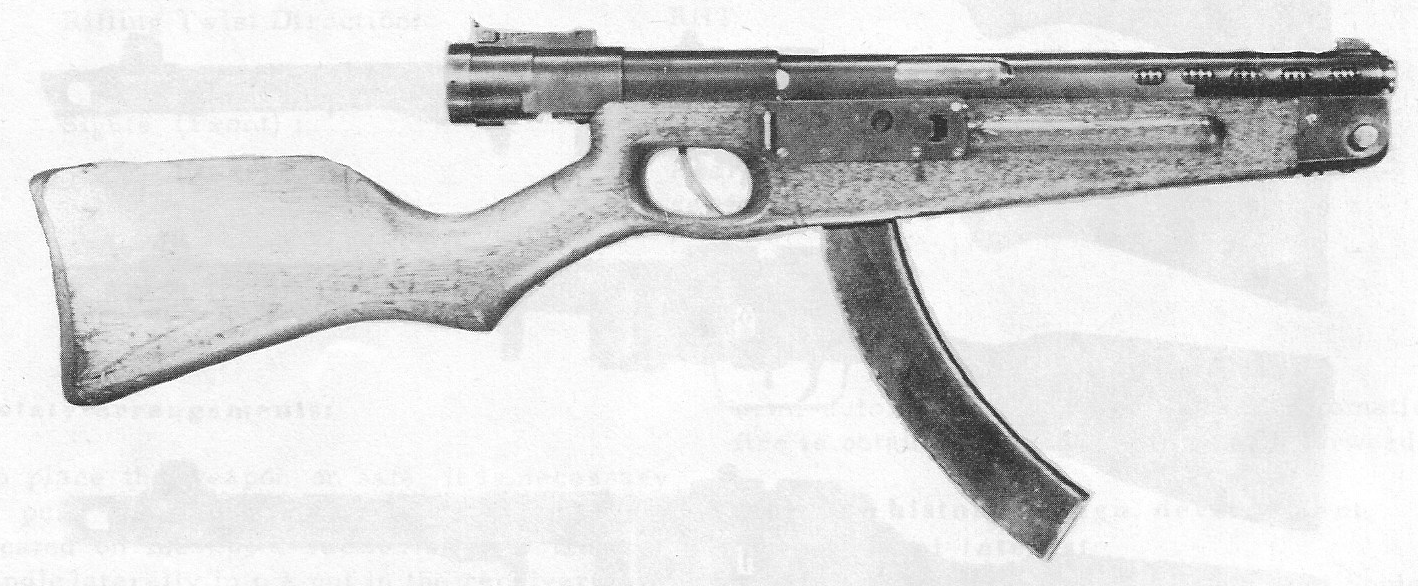The Type 2 Nambu was developed in 1935 as
an improvement over the earlier Type 1 prototype. The Type 1 offered a
promising concept but was ergonomically awkward and uncomfortable to hold,
as it fed from very curved 50-round magazines through the pistol grip. The
Type 2 sought to offer more comfort and practicality by placing the
magazine forward of the trigger, with the whole gun built onto a wooden
stock unit. As with the Type 1, the actual designer of this gun was Maj.
Gen. Shikanosuke Tokunaga, not Kijiro Nambu as is commonly thought. Nambu
simply built the prototypes at his Tokyo factory and filed the associated
patents.
A very small quantity of test models - only about nine - were built in the
mid-1930s on the request of the Imperial Japanese Army. Trials were
carried out until September 1938, when the gun was formally rejected by
the Army, who at that time had no confidence in the concept of submachine
guns. The Navy, however, was somewhat more invested in submachine guns
than the Army and are said to have ordered a rather insubstantial number
of both the Type 1 and Type 2 submachine guns, which were apparently used
by the Special Naval Landing Forces in occupied China during the late
1930s. It is reported that the prototypes of this gun were made in both
8x22mm Nambu and an experimental 6.5mm cartridge, which never came into
official use. The Type 2, by standard, fed from 30-round magazines,
although the long 50-round Type 1 magazines were also compatible.
The action of this gun was much the same as the Type 1, with the only
major difference being the relocation of the trigger group to behind the
magazine. The bolt was fixed in place by a nut to the inside of the long
barrel shroud, meaning that the bolt itself had no independent movement
and was carried at all times by the barrel shroud. The barrel was entirely
stationary, but the shroud moved backwards with the bolt upon firing. The
return spring was not located in the tubular section behind the bolt, but
was instead coiled around the barrel. When the barrel shroud and bolt came
backward, the barrel shroud pressed against the return spring and
compressed it. The spring would then decompress and force the barrel
shroud, carrying the bolt, back to the forward position.
The rear tubular section of the receiver did not house a recoil spring as
one would typically expect, but instead a pneumatic air-compressed bolt
buffer device. The fire rate could actually be adjusted from 500 - 600rpm
by adjusting the pressure exerted by the buffer. This was done by turning
a small valve located underneath the end cap.
It should also be noted that, due to the way in which the gun operated,
there was no cocking slot or retractable cocking handle. The Type 2 was
cocked by retracting the entire barrel shroud backwards. A "handle" of
sorts existed in the form of a solid metal tab welded to the left side of
the barrel shroud.
 The Nambu Type 2 with the bolt and
barrel shroud in rear position. This is an earlier model.
The Nambu Type 2 with the bolt and
barrel shroud in rear position. This is an earlier model.
 The Nambu Type 2 disassembled, showing
the barrel shroud, bolt, return spring, and exposed barrel.
The Nambu Type 2 disassembled, showing
the barrel shroud, bolt, return spring, and exposed barrel.
The operating mechanism of the Type 1 and Type 2 submachine guns was
innovative, but it was not without fault. The main advantage of this
system was the reduction of the overall length of the gun by placing the
return spring around the barrel. This, however, was inherently detrimental
to the reliability of the gun, as the spring would be damaged over time by
the heat exerted by the barrel upon firing. With no heat protection to the
spring, it would wear out much quicker than a conventional blowback gun.
This is perhaps the reason the gun was not initially taken into service.
The early models of the Type 2 featured a tubular bayonet mount underneath
the barrel, however this feature was eliminated on the later models, which
were also shorter in overall length. The pneumatic bolt buffer was also
absent in some of the later produce, presumably to cut production costs.
It is known that during the later stages of World War II, when Japan's
armament situation became desperate, prototype weapons were pressed into
frontline service. Among them were limited numbers of Type 2 submachine
guns. These were found in China and the Pacific, where they were captured
by Allied troops. From 1942 onward the British Army began encountering
this gun, in small quantities, in Singapore and Burma. It was nicknamed by
them as the "bullpup" due to its short length. The Chinese, on the other
hand, went so far as to produce a copy of the gun at Mukden Arsenal. The
Chinese version was chambered in .45 ACP and took some design cues from
the Thompson gun, but employed the same action as the Type 2.
The total wartime produce of the Type 2 Nambu submachine gun is not known,
although it is estimated at anywhere between 50 - 100 units. Certainly
very few of these guns were made.
 The Mukden Arsenal .45 submachine gun, a
Chinese copy of the Nambu Type 2.
The Mukden Arsenal .45 submachine gun, a
Chinese copy of the Nambu Type 2.





